This set of Electrical Machines Multiple Choice Questions & Answers (MCQs) focuses on “Operating (or Performance) Characteristics of Induction Motors”.
1. A 10 kW, 400 V, 3-phase, 4-pole, 50 Hz induction motor develops the rated output at rated voltage with its slip rings shorted. The maximum torque equal to twice the full load torque occurs at the slip of 10% with zero external resistance in the rotor circuit. The slip at the full load torque will be?
a) 2.7%
b) 5%
c) 3.7%
d) 10%
View Answer
Explanation: Tfl/Tem = 2/((sm/sf)+ (sf/sm))
1/2 = 2/((0.1/sf)+(sf/0.1))
s^2-0.4s+0.01=0
s=0.0268.
2. A 10 kW, 400 V, 3-phase, 4-pole, 50 Hz induction motor develops the rated output at rated voltage with its slip rings shorted. The maximum torque is twice the full load torque occurs at the slip of 10% with zero external resistance in the rotor circuit. The speed at the full load torque will be?
a) 1460 rpm
b) 1400 rpm
c) 1360 rpm
d) 1470 rpm
View Answer
Explanation: 1/2 = 2/((0.1/sf)+(sf/0.1))
s = 2.68%
rotor speed = (1-0.0268)=1460rpm.
3. A 10 kW, 400 V, 3-phase, 4-pole, 50 Hz induction motor develops the rated output at rated voltage with its slip rings shorted. The maximum torque is twice the full load torque occurs at the slip of 10% with zero external resistance in the rotor circuit. An external resistance is now tripled in the rotor circuit. Then the slip at which maximum torque occur for the same load torque is?
a) 0.3
b) 0.268
c) 0.03
d) 3
View Answer
Explanation: The load torque is maintained constant.
So, r2/smT = X;
r2/x = 0.1
new value of slip will be, 3*r2/x=0.1
smT = 0.3.
4. A 10 kW, 400 V, 3-phase, 4-pole, 50 Hz induction motor develops the rated output at rated voltage with its slip rings shorted. The maximum torque is twice the full load torque occurs at the slip of 10% with zero external resistance in the rotor circuit. An external resistance is now tripled in the rotor circuit. Then the stator current will _________
a) remain constant
b) increase
c) decrease
d) any of the mentioned
View Answer
Explanation: As the ratio of r2/s is constant, the changes will not be reflected to the stator.
5. Introducing the external resistance increases _________
(i) speed (ii) output power (iii) starting torque
a) (iii)
b) (ii), (iii)
c) (ii)
d) (i), (ii), (iii)
View Answer
Explanation: External resistance only increases the starting torque.
6. Introducing the external resistance decreases _________
(i) speed (ii) output power (iii) starting torque
a) (iii)
b) (ii), (iii)
c) (i), (ii)
d) (i), (ii), (iii)
View Answer
Explanation: Speed and the output power decrease with insertion of the external resistance in the circuit.
7. For a three phase induction motor, maximum torque is double the full load torque and starting torque is 1.6 times the full load torque. To get a full load slip of 5%, percentage reduction in the rotor resistance should be?
a) 62.7%
b) 75%
c) 60%
d) 35%
View Answer
Explanation: Slip at which maxim torque occurs is calculated as smT=0.5.
r2/x2=0.5
for full load slip of 0.05, 1/2 = 2/((0.05/sf)+(sf/0.05))
smT2 = 0.186
reduction in resistance = (0.5×2-0.186×2)/0.5×2 = 63%.
8. The speed-power output characteristic of a 3-phase induction motor is?
a) 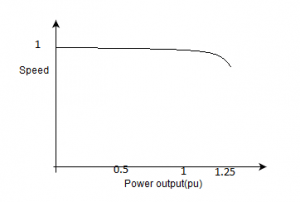
b) 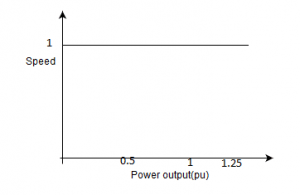
c) 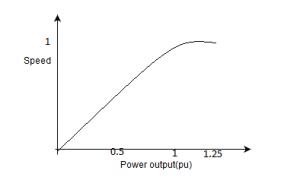
d) 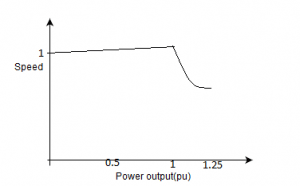
View Answer
Explanation: At no load, rotor speed is near to synchronous speed and the operating slip is not very large, so there is small difference in operating speed and the synchronous speed.
9. The power factor variation of the 3-phase induction motor is given by?
a) 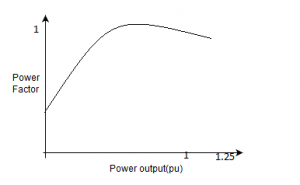
b) 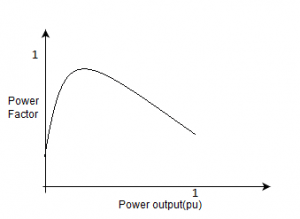
c) 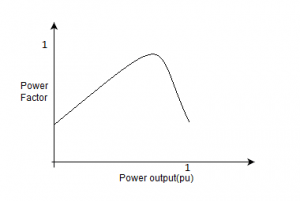
d) 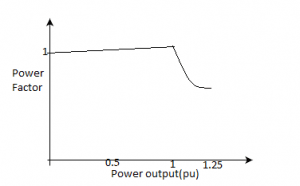
View Answer
Explanation: None.
10. Four students had been conducting conducting experiments on the same induction motor for its efficiency characteristics. Which student has taken the best results?
a) 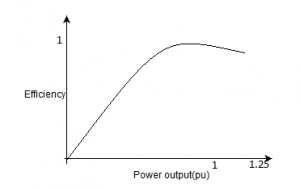
b)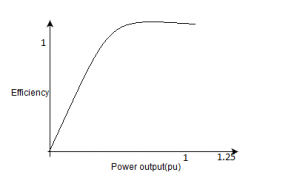
c)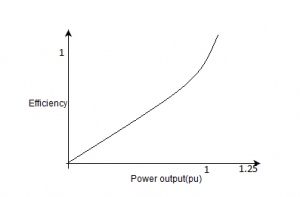
d) 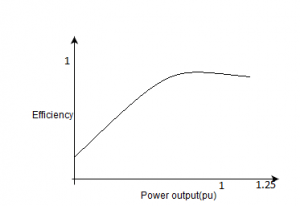
View Answer
Explanation: At no load the shaft output is zero so the efficiency is also zero. At lower loads, fixed losses are more comparable to variable losses. As the load is increased, efficiency also rises.
11. The stator current of the induction motor is given by which of the below?
a) 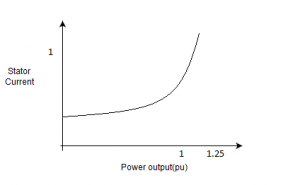
b) 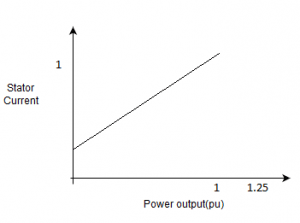
c) 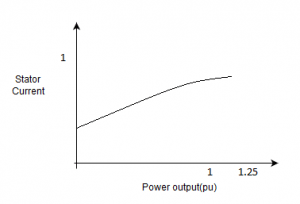
d) 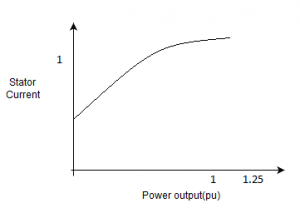
View Answer
Explanation: The no-load current is about 30-50% of rated current. With increase in load current rises correspondingly. It also follows a semi-circle.
12. Slip vs the torque developed in an induction motor is?
a) 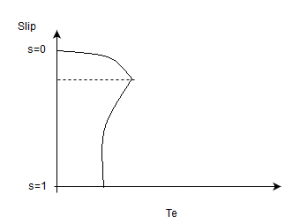
b) 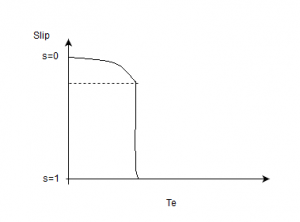
c) 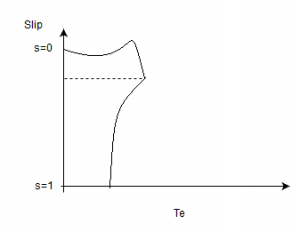
d) 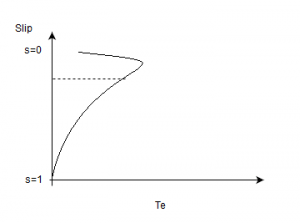
View Answer
Explanation: Try to check the axes.
13. The stable point in the operation of the induction motor is?
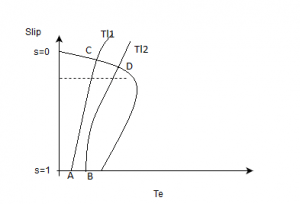
a) C
b) D
c) B
d) A
View Answer
Explanation: If the load torque shift to the Tl2, the motor speed will increase while load torque decreases.
14. At which point shall the induction machine be operated to attain a stable operation?
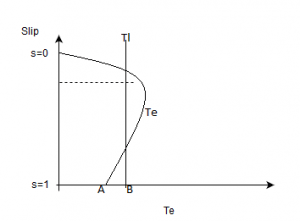
a) The machine will not start
b) A
c) B
d) Both A as well as B
View Answer
Explanation: None.
15. The stable point to use the induction motor possesing the below characteristic.
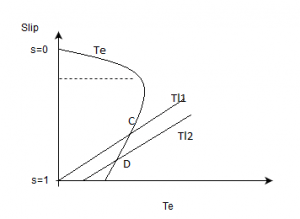
a) C
b) D
c) C and D
d) Machine will not start
View Answer
Explanation: For the stable operation, (dTl/dn)>(dTe/dn).
16. Mark the stable operating point when the load torque shifts from Tl1 to Tl2.
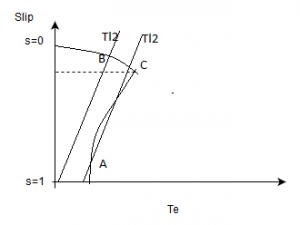
a) A
b) A,B
c) B,C
d) A,C
View Answer
Explanation: For the stable operation, (dTl/dn)>(dTe/dn).
17. A 3-phase, 50 Hz, 6-pole induction motor has a shaft output of 10kW at 930 rpm. Friction and windage losses is 1% of the output. Total stator losses is 600W. What is the rotor input?
a) 10860 W
b) 10100 W
c) 11460 W
d) 11000 W
View Answer
Explanation: Full load slip = 1000-930/1000 = 0.07.
Friction losses = 0.01*10000 = 100 W
Pm = 10000+100 = 10100 W
Rotor input = 10100/0.93 = 108060 W
18. A 3-phase, 50 Hz, 6-pole induction motor has a shaft output of 10kW at 930 rpm. Friction and windage losses is 1% of the output. Total stator losses is 600W. What is the stator input?
a) 10860 W
b) 10100 W
c) 11460 W
d) 11000 W
View Answer
Explanation: Full load slip = 1000-930/1000 = 0.07.
Friction losses = 0.01*10000 = 100 W
Pm = 10000+100 = 10100 W
Rotor input = 10100/0.93 = 108060 W
Stator input = Pg+600 = 11460 W.
Sanfoundry Global Education & Learning Series – Electrical Machines.
To practice all areas of Electrical Machines, here is complete set of 1000+ Multiple Choice Questions and Answers.
If you find a mistake in question / option / answer, kindly take a screenshot and email to [email protected]
